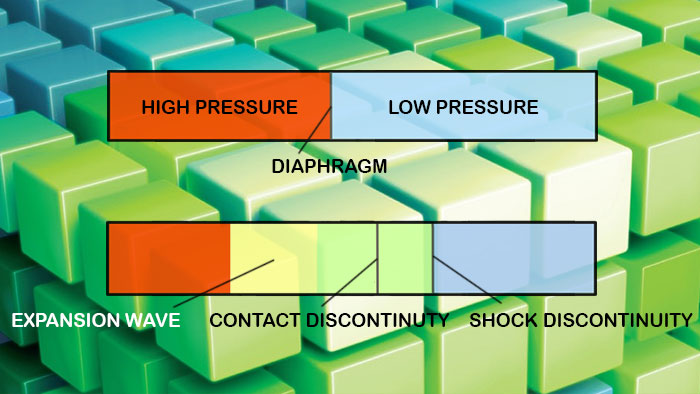 The Sod shock tube is a Riemann problem used as a standard test problem in computational Fluid dynamics. Checkout the article in Wikipedia for a more complete description of the Sod problem. The CUDA platform is a software layer that gives direct access to the GPU's virtual instruction set and parallel computational elements, for the execution of compute kernels.[1]
The Sod shock tube is a Riemann problem used as a standard test problem in computational Fluid dynamics. Checkout the article in Wikipedia for a more complete description of the Sod problem. The CUDA platform is a software layer that gives direct access to the GPU's virtual instruction set and parallel computational elements, for the execution of compute kernels.[1]
In this project we use algorithms presented in Lax [2] and Roe [3] to numerically solve the Sod shock tube problem using CUDA and we use the standard test case for the initial condition (rho_left, P_left, v_left) = (1, 1, 0), (rho_right, P_right, v_right) = (0.125, 0.1, 0) and the reatio of specific heats = 1.4. We compare the results with the anaylitical solution. Moreover, we will compare the run-time and memory cost of solution on cpu in C++ and solution on gpu in CUDA C++.
Run analyticalNumpy/exactRiemann.py by python to get analytical.dat. For analytical results we used sod library from Ibackus's repository[4] which is a simple pythonic implementation of a Riemann solver for the analytic solution of the sod shock tube.
Build and run the solution of cudaShockTube/shockTube.sln in Visual Studio to get lax.dat, roe.dat.
Check "Accept Connections" from Tecplot 360 application -> Scripting tab -> Pytecplot Connections.
Run pytecplot/XYLine.py by python.
- A system with an NVIDIA GPU and CUDA-supporting drivers
- Visual Studio (for Numerical Solution)
- Python for Analytical Solution (for validation purpose)
- Tecplot 360 and pytecplot library (past processing)
[1] Abi-Chahla, Fedy (June 18, 2008). "Nvidia's CUDA: The End of the CPU?". Tom's Hardware. Retrieved May 17, 2015.
[2] P.D Lax and B. Wendroff (1960). “Systems of conservation laws”. Commun. Pure Appl. Math. 13 (2): 217–237.
[3] P. Roe and J. Pike, (1984). “Efficient Construction and Utilisation of Approximate Riemann Solutions,” Comput. Methods Appl. Sci. Eng., no. INRIA North-Holland, pp. 499–518.
[4] https://github.com/ibackus/sod-shocktube
Riemann Solvers and Numerical Methods for Fluid Dynamic, A Practical Introduction, Book by Eleuterio F.toro
NUMERICA, a library of source codes for solving hyperbolic partial differential equation in Fortran language
CUDA Toolkit Documentation
